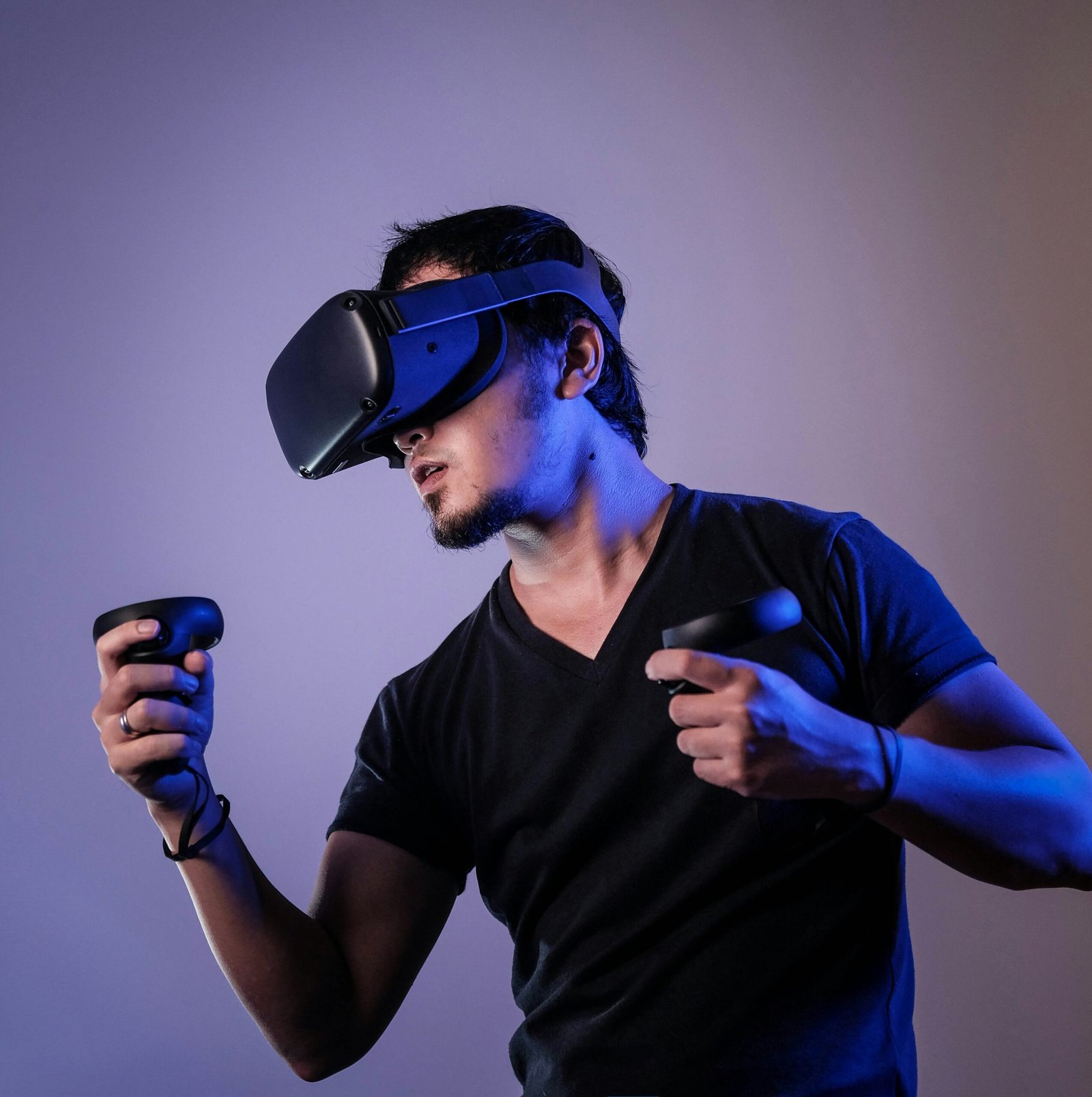Career Opportunities in the World of VR and AR: 5 Rising Fields
Introduction to VR and AR
Virtual Reality (VR) and Augmented Reality (AR) represent some of the most innovative technology developments of the 21st century. While often used interchangeably, VR and AR offer distinctly different experiences. Virtual Reality creates an entirely immersive digital environment that users can interact with, typically through specialized headsets that provide a sensory experience. In contrast, Augmented Reality overlays digital information onto the real world, enhancing the physical environment through devices like smartphones or AR glasses.
The rapid advancement of VR and AR technologies has been nothing short of remarkable. Originally confined to the realm of science fiction, these technologies have swiftly entered the mainstream over the past decade. They are no longer just the domain of gaming and entertainment; their applications span across multiple sectors including healthcare, education, real estate, and manufacturing. The ability of AR to superimpose information over the physical world allows for enhanced training simulations, detailed architectural visualizations, and intuitive user interfaces. Meanwhile, VR provides unparalleled levels of immersion, making it invaluable for training programs, therapeutic interventions, and virtual tours.
This burgeoning influence has fueled an accelerating demand for professionals skilled in VR and AR applications. As industries continue to explore and harness the potential of these technologies, an array of career opportunities has emerged. Talent in this field is now sought after for roles in development, design, content creation, and user experience, amongst others. As we proceed to delve into these specific career paths, it is evident that the world of VR and AR stands at the cusp of exponential growth, poised to transform how we interact with both digital and physical environments.
Field 1: VR/AR Development and Programming
The rise of virtual reality (VR) and augmented reality (AR) has created robust career opportunities for developers and programmers specializing in these cutting-edge technologies. To excel in VR/AR development and programming, proficiency in programming languages such as C#, C++, and Python is essential. These languages form the backbone of VR and AR software, enabling developers to create immersive and interactive experiences.
Moreover, familiarity with development platforms like Unity and Unreal Engine is crucial. Unity, in particular, is widely recognized for its versatility and ease of use in VR and AR applications, making it a preferred choice among developers. Unreal Engine, known for its high-fidelity graphics and powerful performance, is also extensively used, especially in creating visually stunning VR and AR environments. Mastery of these platforms equips developers with the tools necessary to bring their creative visions to life.
The career prospects in VR/AR development and programming are diverse, with several exciting job roles available. A VR/AR Software Engineer focuses on designing and developing the software architecture for VR and AR systems. This role requires a deep understanding of computer graphics, 3D modeling, and real-time rendering techniques.
Another notable role is that of a VR/AR Application Developer. This professional is responsible for creating applications that leverage VR and AR technologies. From educational tools to enterprise solutions, VR/AR application developers build software tailored to various industries’ specific needs.
Finally, the role of a VR/AR Game Developer involves creating engaging and immersive gaming experiences. This position requires a blend of technical skills and creativity, as developers design game mechanics, enhance user experiences, and ensure seamless gameplay in virtual or augmented settings.
Overall, the field of VR/AR development and programming offers abundant career opportunities for those equipped with the right skills and knowledge. By staying current with technological advancements and continually honing their expertise, developers and programmers can significantly contribute to the evolving landscape of VR and AR.
Field 2: VR/AR Design and User Experience (UX)
The realm of VR and AR design and user experience (UX) is pivotal in creating compelling and memorable immersive environments. As the adoption of virtual reality (VR) and augmented reality (AR) technologies accelerates, the emphasis on user-centric design becomes increasingly significant. In this field, the goal is to craft experiences that are not only visually stunning but also intuitive and easily navigable, making VR/AR design and UX roles indispensable.
Key skills essential for a career in VR and AR design and UX include a robust understanding of 3D modeling, graphic design, and UX/UI design principles. Proficiency in tools such as Unity, Unreal Engine, Blender, and Adobe Creative Suite is often required. Furthermore, a deep knowledge of user-centered design methodologies ensures that the applications are both immersive and accessible.
Typical job titles in this ever-growing field encompass VR/AR UX designer, 3D artist, and interface designer. A VR/AR UX designer focuses on shaping the overall user journey, ensuring that interactions within the virtual or augmented environment are seamless. 3D artists create the foundational landscapes, characters, and items, infusing life and realism into the digital space. Interface designers bridge functionality and aesthetics, constructing the interactive elements that users engage with.
The significance of user-centric design in VR and AR cannot be overemphasized. By prioritizing the user’s perspective, designers can optimize comfort, reduce motion sickness, and enhance overall engagement. Effective user experiences are fundamental in creating VR and AR applications for various sectors, including gaming, education, healthcare, and retail. These applications must cater to diverse user needs, ensuring inclusivity and usability across different demographics.
In summary, careers in VR/AR design and UX are vital for the future of immersive technology. As the boundaries of virtual and augmented reality continue to expand, the demand for skilled professionals in designing and enhancing user experiences will grow, offering exciting opportunities for those with the right blend of creativity and technical proficiency.
Field 3: VR/AR Hardware Engineering
The realm of VR and AR hardware engineering is a vital and expanding field that underpins the user experience and technological capabilities of virtual and augmented reality devices. VR/AR hardware engineers play a crucial role in developing sophisticated devices such as VR headsets, AR glasses, and related peripheral equipment.
Hardware engineers in VR and AR are responsible for ensuring that these devices are not only functional but also efficient, ergonomic, and capable of delivering high-quality immersive experiences. They blend principles of electrical engineering, robotics, and sensor technology to create devices that can precisely track movements, render graphics seamlessly, and provide users with a responsive and engaging experience. From conceptual design to prototyping and mass production, hardware engineers are involved at every stage of the development process.
A typical VR/AR hardware engineer might focus on tasks such as circuit design, system integration, and optimizing power consumption. They must possess expertise in various fields, including signal processing, embedded systems, and materials science. These engineers work closely with software developers, product designers, and user experience researchers to ensure the final product meets both technical specifications and user expectations.
Career opportunities in VR/AR hardware engineering are varied and dynamic. Roles such as hardware engineer, product designer, and systems engineer are in demand as companies look to innovate and enhance their VR/AR product lines. Hardware engineers are often tasked with developing new forms of input devices, such as custom controllers and wearable sensors that provide more natural and intuitive interactions in virtual environments.
Moreover, the proliferation of VR and AR applications across industries—from gaming and entertainment to education and healthcare—has led to a heightened demand for professionals with the expertise to push the boundaries of current hardware technologies. These engineers contribute to improving device affordability, increasing battery life, and enhancing display quality, all of which are pivotal for the broad adoption and success of VR and AR technologies.
Field 4: VR/AR Content Creation
The field of VR and AR content creation is burgeoning with career opportunities for those with creative and technical skills. This sector necessitates a diverse array of content, stretching from educational materials and training simulations to immersive entertainment and innovative marketing experiences. As VR and AR technologies continue to evolve, the demand for compelling, high-quality content has never been higher.
One of the primary areas within VR/AR content creation is the development of educational materials. Here, storytellers and educational specialists collaborate to create immersive learning experiences that can offer interactive, hands-on training in various fields, such as medical procedures, engineering, and even space exploration. These applications demonstrate the transformative potential of VR and AR in the educational landscape.
In the realm of entertainment, VR filmmakers and AR content creators are pushing the boundaries of storytelling. They develop interactive stories and visually stunning experiences that fully engage audiences. This requires proficiency in video production, animation, and an understanding of virtual environments. These professionals are instrumental in producing VR films, 360-degree videos, and AR-enhanced experiences that captivate viewers in ways traditional media cannot.
Marketing and advertising are also fertile grounds for VR/AR content creation. Brands are increasingly leveraging this technology to create engaging advertisements and brand experiences. Interactive media specialists play a crucial role here, designing immersive campaigns that enable consumers to interact with products in novel, enthralling ways, whether through virtual showrooms or augmented reality product demos.
The skills needed for a career in VR and AR content creation are diverse and include strong storytelling abilities, video production expertise, and advanced animation skills. Professionals in this field often assume job titles such as VR filmmaker, AR content creator, and interactive media specialist. These roles are in high demand across various industries, from education and healthcare to entertainment and marketing, highlighting the expansive reach and potential of VR and AR technologies.
Field 5: VR/AR Marketing and Sales
The field of VR/AR marketing and sales is expanding rapidly, driven by the increasing adoption of virtual reality and augmented reality technologies across various industries. As companies innovate and develop new VR/AR products and services, the demand for skilled marketing and sales professionals who can effectively promote and sell these technologies is becoming more pronounced. Careers in this domain are not only lucrative but also pivotal to the overall growth and success of VR/AR companies.
One of the key roles in this field is that of the VR/AR marketing manager. These professionals are responsible for designing and implementing comprehensive marketing strategies that showcase the unique selling points of VR/AR products. They must possess a deep understanding of both the technology and the market, enabling them to create compelling narratives that resonate with potential customers. Tasks may include managing marketing campaigns, overseeing social media presence, and collaborating with product development teams to align marketing efforts with product innovations.
Sales executives play a crucial part in the VR/AR industry by driving revenue through direct interaction with clients and customers. They need to be well-versed in the technical aspects of VR/AR products to effectively communicate their value propositions. Sales executives often conduct product demonstrations, develop client relationships, and negotiate contracts to secure deals. Their role is critical in converting leads into sales and ensuring customer satisfaction.
Business development managers in the VR/AR sector focus on identifying new market opportunities and forming strategic partnerships. They analyze market trends, engage with potential partners, and explore avenues for expanding the company’s market reach. Their efforts not only contribute to immediate sales but also to long-term growth and market positioning.
Overall, the marketing and sales of VR/AR technologies require a combination of technical knowledge, strategic thinking, and excellent communication skills. Professionals in these roles are essential in bridging the gap between innovative VR/AR solutions and their targeted markets, ensuring that these revolutionary technologies achieve widespread adoption and success.
Future Trends in VR and AR Career Opportunities
As technology continues to evolve rapidly, the landscape of virtual reality (VR) and augmented reality (AR) careers expands correspondingly. In the coming years, several key advancements are expected to fuel further growth in this dynamic field, creating a plethora of new job opportunities.
One of the most significant drivers of change is anticipated to be the continuous improvements in hardware. With the development of more sophisticated and lightweight VR headsets, AR glasses, and other immersive devices, the user experience is expected to become more seamless and accessible. This will likely catalyze increased adoption across various industries, demanding a workforce proficient in crafting and managing these advanced technologies.
Another pivotal area is the integration of artificial intelligence (AI) within VR and AR environments. AI algorithms can enhance the realism and interactivity of simulated worlds, offering personalized and adaptive experiences. Professionals specializing in AI and machine learning will be sought after to develop these intelligent systems, presenting significant opportunities for those with expertise in both AI and immersive technologies.
Additionally, the rollout of 5G connectivity promises to revolutionize how VR and AR applications are utilized. With its low latency and high bandwidth capabilities, 5G will facilitate more sophisticated and real-time interactions within virtual and augmented spaces. This progression will open up new career paths in network engineering, software development, and content creation, aimed at leveraging the full potential of fast, reliable internet connections.
Furthermore, the application of VR and AR technologies is set to extend into various industries beyond entertainment, gaming, and traditional media. For instance, in healthcare, VR and AR can be used for advanced simulation training, patient diagnostics, and innovative therapy solutions. Similarly, the education sector can benefit from immersive learning environments, enhancing both teaching methodologies and student engagement. Moreover, as remote work becomes more prevalent, VR and AR can provide novel solutions for virtual meetings, collaborative projects, and remote training programs.
Overall, the future holds vast promise for VR and AR career opportunities. As technological advancements continue to unfold, professionals equipped with the right skills and knowledge will find themselves at the forefront of a burgeoning industry, shaping the next generation of immersive experiences and applications.
Conclusion
As we have explored throughout this blog, the world of Virtual Reality (VR) and Augmented Reality (AR) is opening up a variety of compelling career opportunities. The five rising fields—VR/AR Development, UX/UI Design, VR/AR Content Creation, Medical and Healthcare Applications, and VR/AR Education and Training—highlight the diverse ways these technologies are being integrated across different industries. This integration is not just a fleeting trend; it is a transformative movement that is reshaping how we interact with digital and physical worlds.
The significance of VR and AR technologies in advancing career opportunities cannot be overstated. For individuals seeking to tap into these burgeoning fields, a robust education foundation in computer science, graphic design, or related disciplines is crucial. Beyond formal education, continuous skill development through specialized courses, certifications, and hands-on projects can provide a competitive edge. Staying updated with the latest industry trends and technological advancements is equally vital. Engaging in communities, attending conferences, and participating in online forums can provide valuable insights and networking opportunities.
As the adoption of VR and AR grows, so too will the demand for skilled professionals who can innovate and contribute to these technologies. Whether you are a developer, designer, healthcare professional, or educator, there is a place for you in this dynamic and rapidly evolving domain. The potential for impactful and fulfilling careers is immense, offering not only the chance to work on fascinating projects but also the opportunity to be at the forefront of technological innovation.
In conclusion, pursuing a career in VR and AR is not only about adapting to industry demands but also about being part of a revolutionary wave that is transforming various aspects of our lives. Embrace continuous learning, stay curious, and seize the opportunities that this exciting field presents. The future of VR and AR is bright, and those who are prepared will be well-positioned to shape and thrive in this evolving landscape.




No Comments